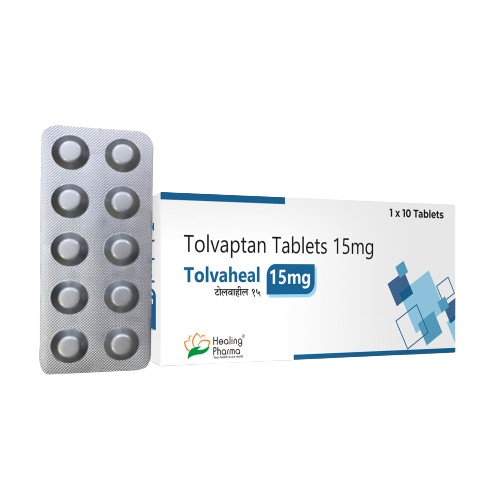Tolvaptan 15 mg Tablets – Complete Guide for Treating Hyponatremia & ADPKD
🔹What Is Tolvaptan 15 mg Used For?
Tolvaptan 15 mg is used in the treatment of:
1. Hyponatremia (low blood sodium levels)
Caused by:
- Syndrome of Inappropriate Antidiuretic Hormone Secretion (SIADH)
- Heart failure
- Liver cirrhosis
2. Autosomal Dominant Polycystic Kidney Disease (ADPKD)
To slow the progression of kidney cyst development and preserve kidney function.
🔹How Tolvaptan Works
Tolvaptan is a selective vasopressin V2 receptor antagonist. It works by:
- Blocking the action of vasopressin, a hormone that causes water retention
- Promoting aquaresis — excretion of free water without losing sodium or potassium
- In ADPKD, reducing cAMP signaling in renal cells, thus slowing cyst growth and kidney damage
🔹Dosage and Administration
🔸 For Hyponatremia (Samsca®):
- Starting dose: 15 mg once daily
- May be increased to 30 mg or 60 mg based on clinical response and sodium levels
🔸 For ADPKD (Jinarc®):
- Used as part of a split-dose regimen (e.g., 45/15 mg, 60/30 mg, 90/30 mg)
- 15 mg tablets are commonly used as the lower evening dose or for titration
Administration:
- Take orally once a day (or twice daily in split-dose)
- Can be taken with or without food
- Should be taken in the morning to reduce nighttime urination
🔹Benefits of Tolvaptan 15 mg
- Effectively raises serum sodium levels
- Improves symptoms of hyponatremia (e.g., confusion, lethargy)
- Slows the progression of ADPKD, delaying the need for dialysis
- Oral once-daily or split-dosing convenience
🔹Common Side Effects
| System Affected | Common Symptoms |
| Renal/Urinary | Frequent urination, increased thirst |
| GI | Nausea, dry mouth, constipation |
| Nervous system | Dizziness, headache |
| Metabolic | Dehydration, electrolyte imbalances |
🔹Serious Side Effects (Monitor Closely):
- Liver toxicity (increased AST, ALT, bilirubin)
- Rapid sodium correction (risk of osmotic demyelination)
- Hypernatremia
- Severe dehydration or low blood pressure
💡 Liver function tests are required regularly, especially in ADPKD patients.
🔹Warnings & Precautions
- Do not use in patients with an inability to perceive or respond to thirst
- Not recommended for hypovolemic hyponatremia
- Avoid in patients with liver disease unless essential
- Requires hospital initiation for hyponatremia due to risk of overcorrection
- Avoid use during pregnancy and lactation
🔹 Drug Interactions
| Drug Type | Effect |
| CYP3A4 inhibitors (e.g., ketoconazole) | Increase tolvaptan levels (avoid) |
| CYP3A4 inducers (e.g., rifampin) | Reduce tolvaptan effectiveness |
| Diuretics | May increase dehydration or electrolyte loss |
| Grapefruit juice | Inhibits metabolism, increases drug exposure |
🔹Liver Monitoring (Especially in ADPKD)
Tolvaptan can cause serious liver damage, particularly in long-term use for ADPKD. Monitoring protocol:
- Baseline liver tests before starting
- Monthly monitoring for first 18 months
- Then every 3 months thereafter
- Discontinue if signs of liver injury appear
🔹Storage Instructions
- Store at 20–25°C (68–77°F)
- Protect from moisture, heat, and direct sunlight
- Keep in original packaging and out of reach of children
🔹Patient Tips
- Stay hydrated but avoid overhydration — follow physician advice
- Monitor for signs of liver problems: yellowing skin, dark urine, abdominal pain
- Do not skip liver function tests if used for ADPKD
- Report any signs of overcorrection of sodium (e.g., seizures, confusion)








Reviews
There are no reviews yet.